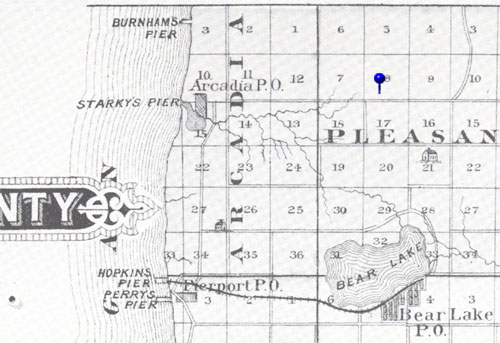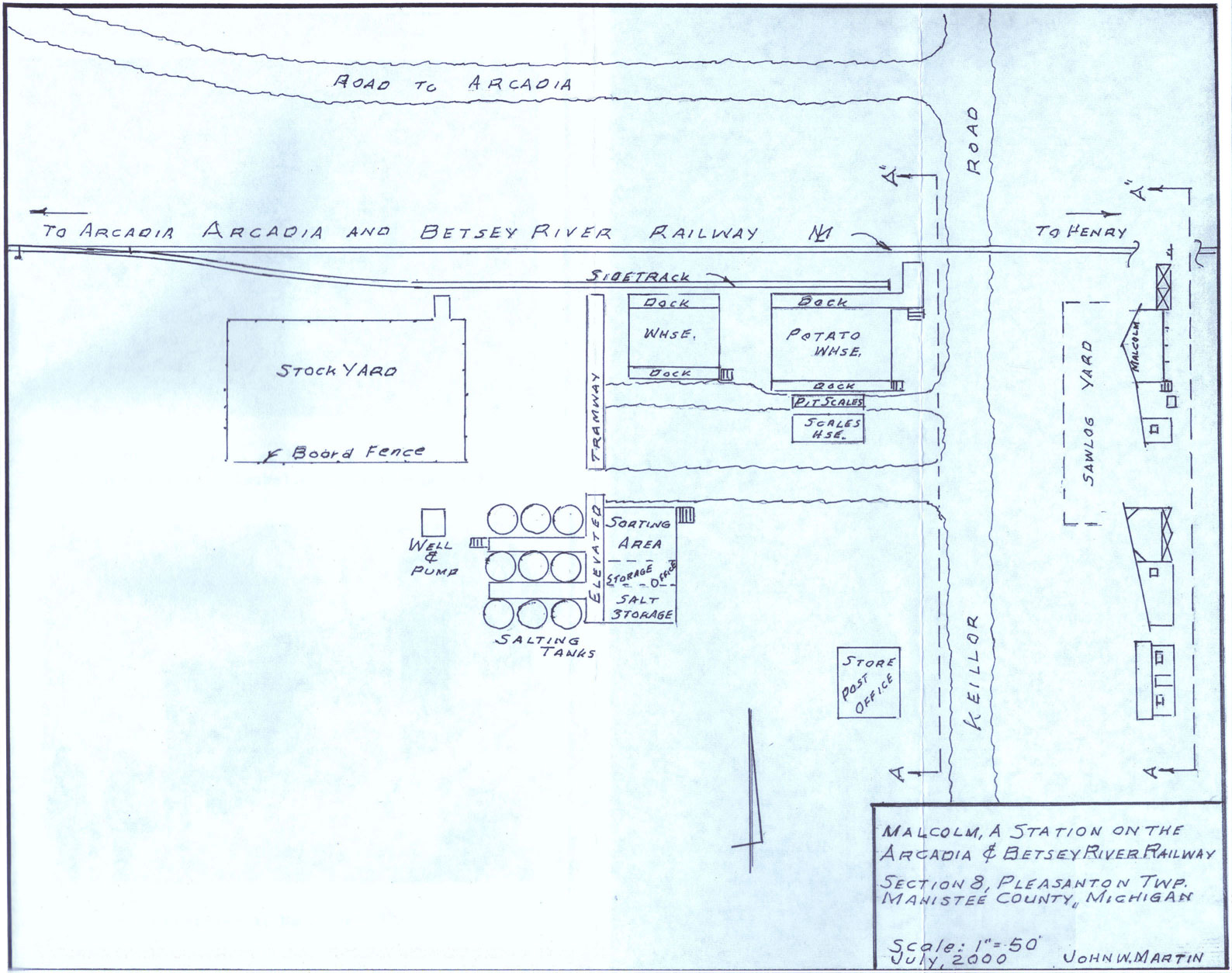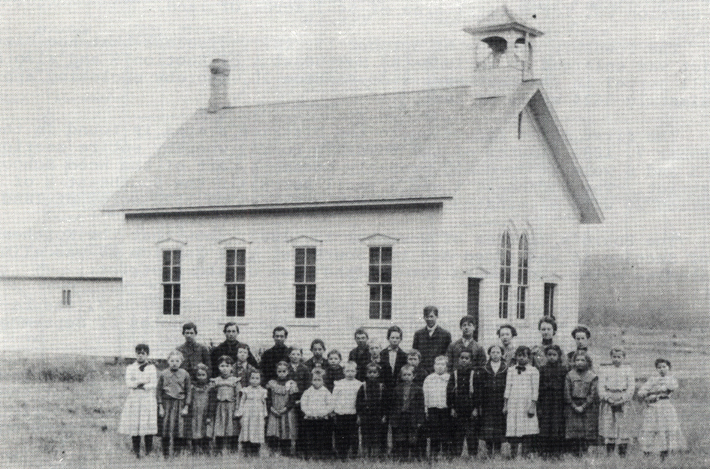Malcolm, Michigan
Next | Previous | Return to Start
|
The Starke Land & Lumber Company's logging railroad traveled from Arcadia to an area about 5 miles east called Malcolm. In 1893, the narrow gauge railway was converted to standard gauge for the Arcadia and Betsey River Railway (ABRR), rerouted around grades, and extended farther east to Henry and Copemish. Malcolm was a key stop, and it grew as a settlement with a railway siding, stockyard, potato warehouse, pickle processing plant, store, post office, school, lumber yard, homes, and other miscellaneous buildings. Where Was Malcolm? |
|
|
|
|
|
Malcolm. Population 25. On the A&BR Ry in Pleasonton township, Manistee county, 7 miles from Arcadia, 25 north of Manistee, the county seat, 12 from Frankfort, the nearest banking point, and 130 from Grand Rapids. Improved farm land averages $50 per acre. Exp., Am. H D Farnsworth, postmaster. Farnsworth, H D, general store and express agent. Millard, Miss Julia, music teacher. Pleasonton Cornet Band. |
|
The Malcolm Railway StopThe Starke Land and Lumber Company had a narrow gauge railway used to haul sawlogs west to the sawmill at Arcadia. The grade was steep, but the railway only went uphill with empty flatcars and returned downhill loaded with logs. |
|
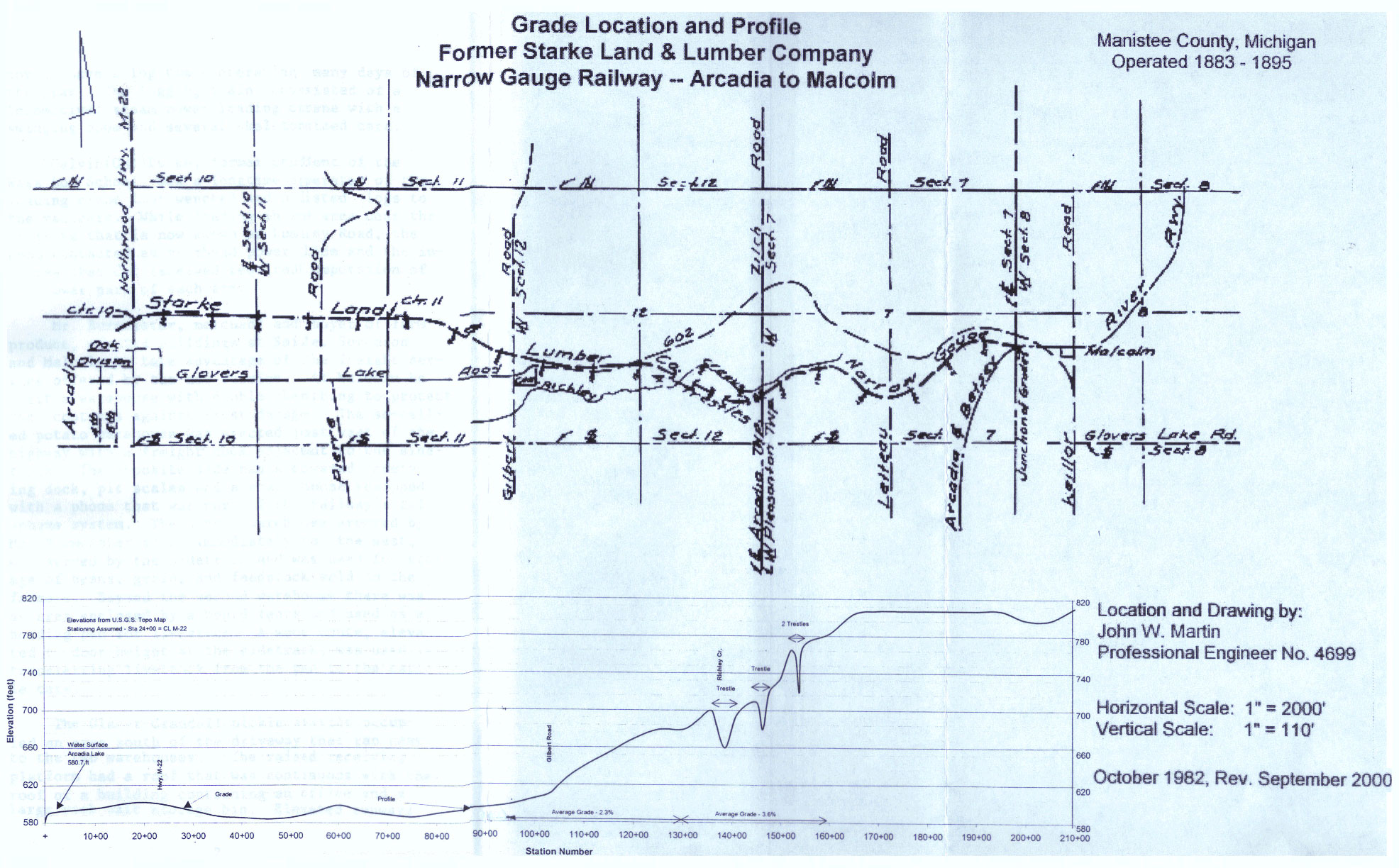 |
|
| The Route of the Narrow Gauge Railway The Starke Land & Lumber Company Company's railway ran from Arcadia east to Malcolm. The top of the figure shows the route from Arcadia east to Malcolm on the right. The bottom of the figure shows the elevation that corresponds to each location on the route. Note the sudden elevation changes just west of Malcolm that required the use of four trestles. -- Map by John W. Martin. Used with permission. |
|
|
“Much credit is due the Engineer and others for alignment selection, trestle design and cost containment, thereby making the route feasible for one-way hauling. "Descending 215 feet over a curvilinear alignment benched to the side of a steep ravine, crossing four trestles and using the engine to break a trainload of logs must have given the operating crew some concern for their safety. On the other hand, the 1.25 mile section was a spectacular ride.” |
|
|
In 1893, construction began on the standard gauge railway. The route to Malcolm was changed to avoid the unreasonable grades and the costly maintenance of four trestles. The new railway could haul loads in either direction. In addition, the route was extended from Malcolm to Henry, where the ABRR connected with two other railways and the rest of the world. |
|
 |
|
| The Route of the Standard Gauge Railway The dotted line on the left shows the old narrow gauge route to Malcolm. The solid line shows the route of the new standard gauge railway. |
|
The Malcolm Station on the Arcadia & Betsey River RailwayByron Burmeister bought produce to send by rail to eastern markets. He operated buying stations at eight points along the Manistee and North Eastern Railroad and the Arcadia and Betsy River Railroad. (See The History of the Sorenson Station.) “At Malcolm he built a warehouse with double sheathing to protect the contents against frost damage. The so-called potato warehouse was erected just west of the highway with a freight dock adjacent to the sidetrack . The opposite side had a covered receiving dock, pit scales and a scale house equipped with a phone that was part of the railway's telephone system. The second house erected by Mr. Burmeister stood immediately to the west, was served by the sidetrack and was used for storage of beans, grain, and feedstock sold to the farmers. Beyond the second warehouse there was an area enclosed by a board fence and used as a holding pen for livestock. A wood chute, elevated to door height at the sidetrack, was used in transferring livestock from the pen to the cattle cars. "The Glacier-Crandall pickle station occupied an area south of the driveway that ran next to the two warehouses. The raised receiving platform had a roof that was continuous with the roof of a building containing and office and a large rock salt storage bin. Elevated runways with a removable section across the driveway was used in removing shipments of rock salt from boxcars and to load salted pickles into tanks mounted on special railcars." |
|
|
|
|
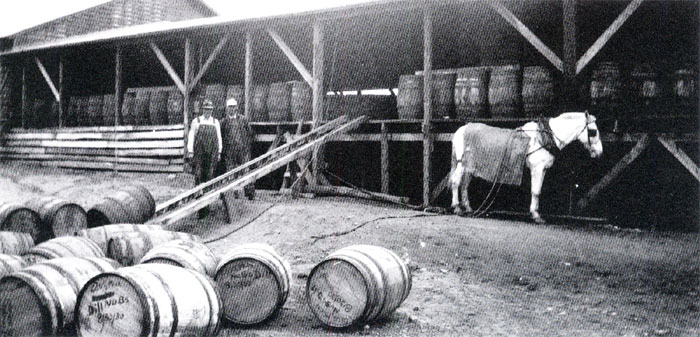 |
|
| Barrels of Pickles This is a warehouse in Malcolm used to store pickles produced from local cucumbers. The label on the barrel in the foreground reads "Dill No 8s 8/30/30." |
|
|
George Iverson, an agent for Byron Burmeister, supervised business operations at ABRR stations. From 1903 until his death in 1922, Charles Eggart managed the warehouses and pickle station at Malcolm. For some of that time he was assisted by Thomas Snyder, a disabled veteran of the Civil War with a wooden stump for one lower leg. After Eggart's death, Laurence Farnsworth managed the pickle station. From 1923 until the station ceased operation in 1936, Frank C. Martin was the Malcolm station agent. Henry Farnsworth owned and operated a small general store and post office south of the warehouses and west of Keillor road. A widower, he lived at the store and served as postmaster. According to John W. Martin, the store had a classic wood burning stove around which locals would congregate daily to swap stories and opinions. East of Keillor Road was a sawlog yard. In the winter, which was typically when logging was performed, local farmers would fill the yard with hardwood logs. A train with a crane could pick them up for transport to the sawmill in Arcadia or elsewhere. Life at the Station In the early 1900s when Malcolm was busiest, each day a passenger train made a round trip in morning and one in the evening between Arcadia and Copemish providing passenger and mail service to stations along the line including Malcolm. Freight and logging trains made frequent runs too as needed. Malcolm received shipments of farm machinery, furniture, coal, rock salt, animal feed, and many other items. Malcolm shipped livestock, salted pickles, potatoes, beans, grain, hay, sugar beets, and apples. In cooler months, Malcolm shipped cream to Blue Valley Creamery in Grand Rapids. In the fall and spring, farmers delivered wagonloads of potatoes. Using a hand powered grader, the potatoes were sorted into two grades: U.S. number one and others. Potatoes that were not U.S. number one grade were rejected, and the farmer had to find other uses for them. U.S. number one grade potatoes went directly from the grader into burlap bags capable of holding 150 pounds, marked with a logo, sewn shut, and either stored in the warehouse or placed directly into a boxcar in stacks about six feet high. The farmer received a check based on the total weight of U.S. number one potatoes. The Malcolm School The wood frame school in Malcolm was originally called the Wass School. Land was purchased from Daniel Malcolm for warehouses, the pickle station, and store, so on railroad maps, the stop was called Malcolm, and eventually the school became known as the Malcolm School. |
|
|
|
|
The Demise of MalcolmDuring the 1930s, as the economy slowed and roads and trucking improved, the railway was used less and less to ship goods. By 1936, the last full year of operation, the railway brought in only $3.00 in passenger revenue. In 1937, the tracks were torn up leaving railway stops like Malcolm stranded. Some businesses continued, and the Malcolm School still taught local children, but the settlement was never the same. |
|
